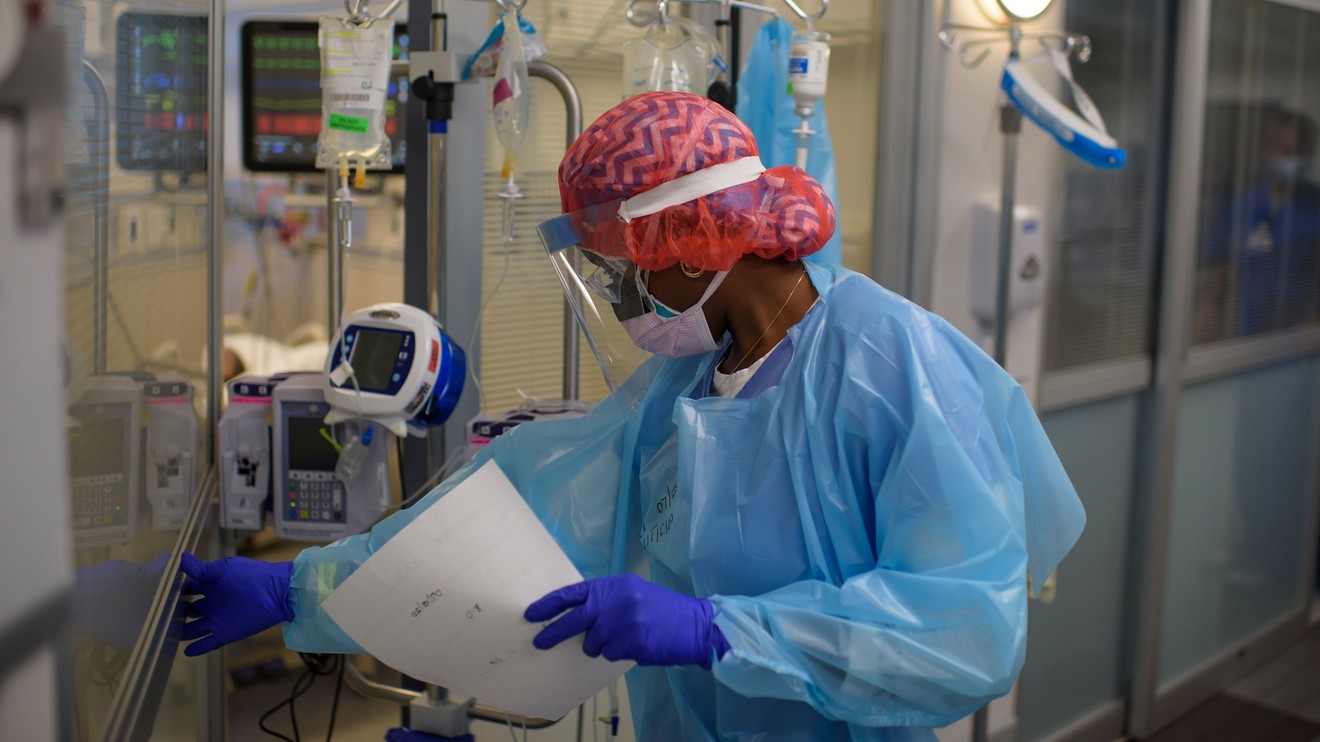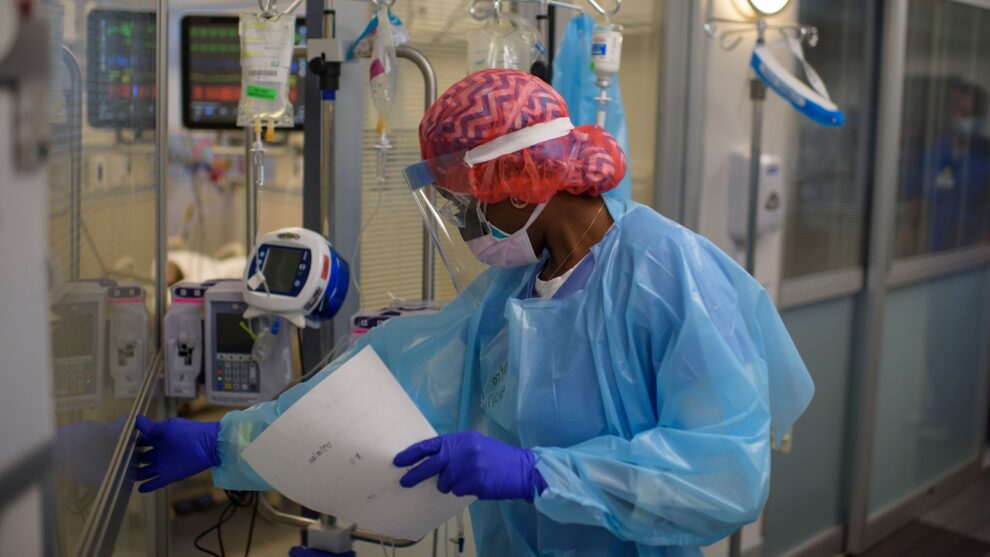
The global tally of confirmed cases of the coronavirus illness COVID-19 climbed above 51 million on Tuesday with new cases racing across the U.S. and Europe as more localities opted to impose restrictions on movement to curb the spread.
The U.S. counted 130,553 new cases on Monday, according to a New York Times tracker, and at least 745 people died. The U.S. has averaged 116,447 cases a day in the past week, up 64% from two weeks ago. Cases are rising in 47 states and at least 12 set records on Monday.
Per capita new case numbers are highest in North Dakota, South Dakota, Iowa and Wisconsin, filling hospitals and raising concerns that health systems will be overwhelmed as winter sets in.
More than 10.1 million Americans have been confirmed to have contracted COVID-19 and 238,251 people have died, according to data aggregated by Johns Hopkins University, accounting for about a fifth of both global counts.
“This is what exponential math looks like,” Malia Jones, a social epidemiologist with the University of Wisconsin Applied Population Laboratory and the UW-Madison Department of Community and Environmental Sociology, told MarketWatch.
“ “This is what exponential math looks like.” ”
“Everything seems fine until quite suddenly it seems completely out of control. We’ve been seeing the slow build to this for a month, and we have also seen little or no action to put the brakes on it. This is a predictable outcome, unfortunately. And we will keep on posting record numbers of cases day after day unless something changes,” she said.
Wisconsin’s hospital system is at 88% capacity, according to the state’s health department, and health care workers are bracing for a wave of admissions. That’s a worry because those patients will need hospital care to survive and there is only so much space, said Jones.
“100,000 cases diagnosed today means a huge wave of people coming into the hospital next week, expecting access to staff, medicine, ventilators, and all sorts of interventions to keep them alive,” she said. “We only have so much to go around. Once we run out of space in hospitals, what do we do? Do we turn away people who are struggling to breathe? Do we turn away people who are having heart attacks or motorcycle accidents?
“Having to make calls like that is not a place anyone wants to be. We saw Italy and parts of New York City in that exact position in the spring. That is the situation we’ve all been working to prevent.”
There are currently 59,275 COVID-19 patients in U.S. hospitals, according to the COVID Tracking Project, the highest number since July 25 and up 70% from a month ago. North Dakota is at 89% capacity, according to its state health department, while South Dakota is at about 64% capacity.
The problem in rural areas is exacerbated by the fact that so many hospitals in remote areas have shut down in recent years. Since 2005, 174 rural hospitals in the U.S. have closed, according to the Cecil G. Sheps Center for Health Services Research, a unit of the University of North Carolina that tracks the data. Since 2010, 132 rural hospitals have closed, the data shows.
“We are already seeing people being transferred from Northern Wisconsin — which is a 4 or 5 hour drive from here — to UW Madison’s hospital for COVID care,” said Jones. We’ll be seeing more of that in the coming weeks…. It’s going to be a double whammy when the COVID positive numbers we are seeing posted this week come home to roost.”
As the virus continues to spread by community transmission, nursing homes in the Midwest states are suffering a spike in new infections, which rose 120% in the week of October 18, according to the American Health Care Association and the National Center for Assisted Living.
“As we feared, the sheer volume of rising cases in communities across the U.S., combined with the asymptomatic and pre-symptomatic spread of this virus, has unfortunately led to an increase in new COVID cases in nursing homes,” said Mark Parkinson, President and CEO of AHCA/NCAL. “It is incredibly frustrating as we had made tremendous progress to reduce COVID rates in nursing homes after the spike this summer in Sun Belt states. If everybody would wear a mask and social distance to reduce the level of COVID in the community, we know we would dramatically reduce these rates in long term care facilities.”
In other news:
• Celebrations around the U.S. at the weekend after Democrat Joe Biden was declared winner of the 2020 presidential election have raised concerns among health experts that some will become superspreader events, MarketWatch’s Nicole Lyn Pesce reported. Dr. Leana Wen, an emergency physician and public health professor at George Washington University who previously served as Baltimore’s health commissioner, told MarketWatch that she was “extremely concerned” while watching these celebrations being broadcast on the news and across Facebook, TikTok and Twitter. “The last thing that should be happening in the middle of a pandemic, especially a raging pandemic like this, is large gatherings of people,” said Wen. She suggested that those who attended these events should considering quarantining for 14 days and getting tested for COVID-19.
Read now:Biden’s pandemic plan: Restore Obamacare, mandatory masks, paid sick leave and free COVID-19 tests
• After Monday’s positive vaccine trial data from Pfizer Inc. US:PFE and BioNTech SE US:BNTX, the U.S. Food and Drug Administration granted emergency use approval to Eli Lilly & Co.’s US:LLY COVID-19 antibody treatment, MarketWatch’s Jeremy Owens reported. The monoclonal antibody treatment called bamlanivimab is seen as a potential treatment for those with mild to moderate forms of the coronavirus. The study that led to Monday’s EUA showed reduced viral load as well as rates for symptoms and hospitalization, Lilly said in announcing the EUA on Monday.
• BioNTech posted quarterly earnings on Tuesday and said manufacturing plans foresee production of up to 1.3 billion doses next year of the vaccine it is developing with Pfizer Inc. The companies could supply up to 50 million doses before the end of this year, BioNTech said. A request for an emergency-use authorization from the U.S. Food and Drug Administration would follow a safety milestone the companies expect to achieve in the third week of November. The German biotech posted a loss and revenue that was more than double the year-earlier number.
• New Jersey Gov. Philip Murphy outlined new restrictions for the Garden State, saying restaurants and bars will shut down indoor service at 10 p.m. starting Thursday. The move came as the Northeast, an early hot spot in the pandemic, is seeing a worrying rise in new cases. In New York City, Mayor Bill de Blasio said the city is “dangerously close” to a second wave. “We need to do everything in our power to stop the coronavirus from reasserting in New York City. We have to stop a second wave from happening here, it is getting dangerously close.”
• The COVID-19 death toll in Europe is poised to pass 300,000, Reuters reported, and officials are worried that they will continued to rise in the winter months. Europe accounts for about a quarter of the current global case tally and death toll, as new infections have surged following lockdowns earlier in the year that appeared to contain the spread. Europe has counted 280,000 cases a day in the past week, up 10% from the week earlier.
Latest tallies
The number of confirmed cases of COVID-19 worldwide now stands at 51.2 million, the Johns Hopkins data show, and the death toll is 1.3 million. At least 33 million people have recovered from COVID-19.
Brazil has the second highest death toll at 162,628 and is third by cases at 5.7 million.
India is second in cases with 8.6 million, and third in deaths at 127,059.
Mexico has the fourth highest death toll at 95,027 and 10th highest case tally at 967,825.
The U.K has 49,329 deaths, the highest in Europe and fifth highest in the world, and 1.2 million cases, or eighth highest in the world.
China, where the disease was first reported late last year, has had 91,693 cases and 4,741 fatalities, according to its official numbers.
What’s the latest company news?
• American Airlines Group Inc. US:AAL proposed a public offering of 38.5 million shares of common stock, a day after the stock soared 15.2% amid a big run up in airline shares and the broader stock market on positive news on a potential COVID-19 vaccine. Based on Monday’s stock closing price of $13.20, the offering would raise $508.2 million. American plans to grant the underwriters options to buy up to an additional 5.78 million shares to cover allotments. The company plans to use the proceeds from the offering for general corporate purposes and to enhance the company’s liquidity position.
• Carnival Corp. US:CCL disclosed a proposed stock offering program valued at up to $1.5 billion. The filing to sell more shares comes after the stock soared 28.8% on Monday, and less than two weeks after the completion of its previous $1 billion stock offering program. Based on current stock prices, the proposed $1.5 billion “at-the-market” (ATM) equity offering program could represent up to about 85.57 million shares, or 11.9% of the shares outstanding. The company plans to use proceeds from the new stock offering for general corporate purposes. Carnival has tapped capital markets repeatedly during the pandemic.
• Home builder D.R. Horton Inc. US:DHI reported fiscal fourth-quarter profit and revenue that rose well above expectations, amid an 81% jump in net sales orders. Revenue grew 27.0% to $6.40 billion, beating the FactSet consensus of $5.84 billion. Net sales orders increased 81% to 23,726 homes, above the FactSet consensus of 16,337 homes. The value of sales orders grew 84% to $7.3 billion, implying an average price per home of about $307,679, compared with expectations of $298,180. The company raised its quarterly dividend to 20 cents a share from 17.5 cents a share, with the new dividend payable Dec. 14 to shareholders of record on Dec. 4. For fiscal 2021, the company said it remains cautions given the ongoing effects of the pandemic, and the uncertainty regarding how long it will affect the economy. Still, the company expects revenue to be $24.0 billion to $25.0 billion, above the FactSet consensus of $23.3 billion.
• Square Inc. US:SQ priced a $1 billion convertible bond offering on Tuesday and entered hedging agreements that aim to reduce dilution on conversion, joining the many companies raising record amounts of capital during the pandemic. The payment systems company said it is offering $500 million of senior notes due 2026 and $500 million of notes that mature in 2027. The 2026 notes will not bear interest and the principal will not accrete. The 2027 notes will bear interest at a rate of 0.25% per year. The initial conversion rate for each series is 3.3430 shares of Class A common stock per $1,000 principal amount, or about $299.13 per share.











Add Comment